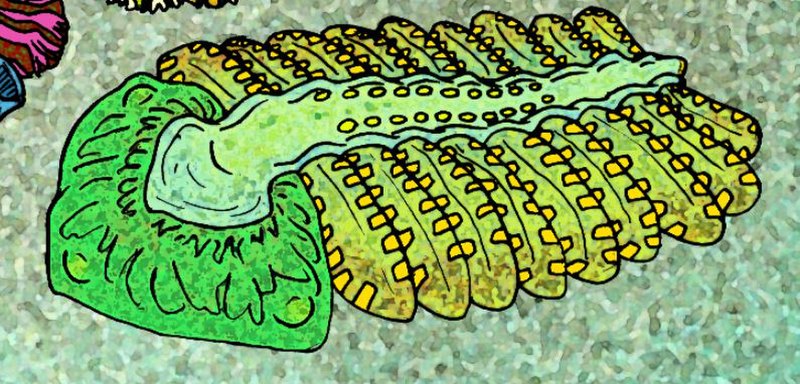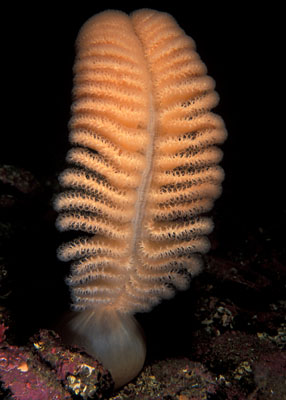| The original Charnia masoni fossil. |
 |
| Modern sea pens. |
This interpretation was first challenged when Dolf Seilacher presented his Vendozoa classification, suggesting that the Ediacaran forms were an evolutionary experiment in multicellularity which left no descendants. The nature of what are now referred to as Vendobionts has changed a lot since Seilacher's ingenious proposal. Originally they were a separate, metacellular, kingdom, before later becoming an extinct phylum which diverged before true animals evolved. Eventually Seilacher settled on the idea that Vendobionts were large, quilted protists.
Seilacher's view of a separate phylum is widely accepted, though his classification of the Ediacaran Vendobionts as protists is less well accepted. Charnia is classified as a Rangeomorph - a taxon containing the frondose fossils of the Ediacaran, believed to potentially be a monophyletic clade (meaning they are not from separate groups but have similar morphologies because they are closely related) morphospace data appears to bear this out.
Charnia's connection to the sea pens was not completely thrown out, particularly because the classification of Charnia is hugely important. If it can be connected to modern forms then the Garden of Ediacara was not so bizarre after all, perhaps evolution is actually quite predictable. If, however, it was a failed experiment, then the Ediacaran remains ridiculously enigmatic, positively alien to us. The connection to sea pens was made through a Cambrian frond-like fossil called Thaumaptilon, which I elucidated here. At the time I did not want to comment on a potential relationship with Charnia, but now I know that they were unlikely to have been related. One simple reason I will give is that Charnia has no stalk running down the centre, yet Thaumaptilon does, though a much better case can be made. Charnia's potential connection to the sea pens took its heaviest blow when it was shown that it grew in a very different way to sea pens. Ontogeny is important in connecting disparate fossil forms as it can be inferred from fossil data and is often quite evolutionarily rigid. Sea pens grow by adding extra polyps to the bottom, whereas Charnia did the opposite and added to the tip.
In working out the evolutionary relationships of many Ediacaran forms, particularly rangeomorphs, it seems that working out their life cycle might be the key. Many have overlapping morphologies which may be different growth stages. With heterochronic evolution changes in developmental timing produces different adult-stage morphologies, allowing a juvenile form to reach sexual maturity for example. These overlapping forms may also be different variations of the same organism, but from different environmental conditions (ecophenotypic variation) much like the variation seen in people from different continents. Bradgatia is one such form, as it is like a bush of Charnia. Many fossils are spindle forms (e.g. Fractofusus) which resemble two Charnia stuck end to end, branching outwards. All have fractal branching frondlets.
 |
| Bradgatia from Charnwood Forest. Photograph by Tina Negus. |
 There are many other rangeomorph fossils which resemble Charnia. Unsurprisingly Charniodiscus is one such fossil, also found in Charnwood Forest, a cast of which is pictured to the right, upside down, with myself using it for a rather lewd pose. This specimen is small compared to the 2m long Charnia found in Newfoundland.
There are many other rangeomorph fossils which resemble Charnia. Unsurprisingly Charniodiscus is one such fossil, also found in Charnwood Forest, a cast of which is pictured to the right, upside down, with myself using it for a rather lewd pose. This specimen is small compared to the 2m long Charnia found in Newfoundland.The mysterious ivesheadiomorphs, or "pizza-discs", have recently been interpreted as the decayed remains (taphomorphs) of Charnia and related taxa.
 |
An ivesheadiomorph. |
Antcliffe, J.B.; Brasier, M.D. (2007a). Charnia and sea pens are poles apart. Journal of Geological Society 164 (1): 49.
Antcliffe, J.B.; Brasier, M.D (2007b). Towards a morphospace for the Ediacara biota. 377–386. In VICKERS-RICH, P. and KOMAROWER, P. (eds). The rise and fall of the Ediacaran biota. Geological Society of London Special Publication 286, London, 456 pp
Brasier, M.D. & Antcliffe, J.B. 2004. Decoding the Ediacaran enigma. Science, 305, 1115–1117.
Ford, T.E. 1958. Precambrian fossils from Charnwood Forest. Proceedings of the Yorkshire Geological Society, 31, 211–217.
Liu, A. G.; McIlroy, D.; Antcliffe, J. B.; Brasier, M. D. (2011). Effaced preservation in the Ediacara biota and its implications for the early macrofossil record. Palaeontology: In press.
Antcliffe, J.B.; Brasier, M.D (2007b). Towards a morphospace for the Ediacara biota. 377–386. In VICKERS-RICH, P. and KOMAROWER, P. (eds). The rise and fall of the Ediacaran biota. Geological Society of London Special Publication 286, London, 456 pp
Brasier, M.D. & Antcliffe, J.B. 2004. Decoding the Ediacaran enigma. Science, 305, 1115–1117.
Ford, T.E. 1958. Precambrian fossils from Charnwood Forest. Proceedings of the Yorkshire Geological Society, 31, 211–217.
Liu, A. G.; McIlroy, D.; Antcliffe, J. B.; Brasier, M. D. (2011). Effaced preservation in the Ediacara biota and its implications for the early macrofossil record. Palaeontology: In press.
Seilacher, A. (2007) The nature of vendobionts. 387-397. In VICKERS-RICH, P. and KOMAROWER, P. (eds). The rise and fall of the Ediacaran biota. Geological Society of London Special Publication 286, London, 456 pp
Shu, D.-G., Conway Morris, S. & Han, J. et al. 2006. Lower Cambrian vendobionts from China and early diploblast evolution. Science, 312, 731–734
Shu, D.-G., Conway Morris, S. & Han, J. et al. 2006. Lower Cambrian vendobionts from China and early diploblast evolution. Science, 312, 731–734






